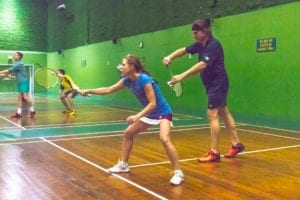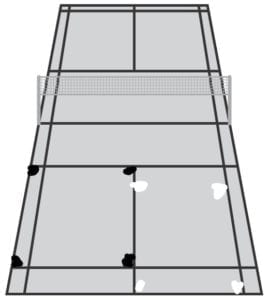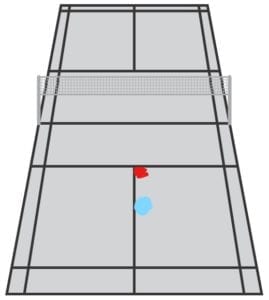Hey everyone! Today, I will be talking about badminton serving drills to help you fix you serves! A good serve will win you lots of points while a bad serve will cause you to lose many. Make sure you’re making good serves!
I remember all those points that lost me the game and match because I failed to serve well, especially in doubles. This gave me a despise for playing doubles.
But it wasn’t just badminton doubles, singles had the same effect where half of my serves would be killed right away.
This was when I realized, it was my serves.
So I decided to take it upon myself to practice my serves. Going through all the tedious service practice will reward like crazy. After all, how are you going to use any other skills if your serve never gets through?
Here are some serving drills to help you get good at badminton but first, we need to know some basics about the serve.
Backhand vs. Forehand Serves
So, backhand or forehand?
There’s actually a right or wrong situation to use each. Let’s start with backhand serves.
Backhand serves are more versatile because they are used in all types of badminton games. In fact, for doubles, you should be only using a backhand serve.
Backhand serves generally have more control. Thus you can make serves as tight and close to the service line and net. That’s why you serve backhand in doubles. You don’t want your opponent to try and kill the shuttle right off the bat. Instead, you want to force them to lift and push your team onto the offense.
A backhand serve in singles is usually faster and goes a bit further away from the service line, but it’s still just as tight to the net. Often times you’ll see professional men’s singles players only serve backhand the reason being the smashes are too strong if they try to make a long serve.
For mixed doubles, it’s generally the same as doubles except that when you’re a guy, you serve like a singles player almost.
Flicks with the backhand serve can be incorporated to mix up your opponent and rack up easy points from time to time. It’s definitely recommended that you practice them. Just be wary of the short line in doubles. Many beginner’s flicks go out in doubles.

Forehand serves are usually limited to just singles. This is because they’re great for hitting high and into the backcourt which becomes useless in doubles because of the short service line.
Usually, you’ll see youth players and professional women use the forehand serve. Players in these categories are generally shorter, don’t jump as high, and have less power. Which means a long and high serve is great for stalling out your opponent’s stamina.
You can also do forehand short serves to mix things up. The short forehand serve isn’t as good as the backhand short serve thus it’s not used for doubles.
So short summary, use backhand if you’re playing doubles and you have a choice between forehand and backhand for singles.
Service Positioning
Then there’s the positioning of the serve. You stand in different places to serve in singles and doubles. This is mostly to prepare you for the rally.
In singles and if you’re a guy playing mixed doubles, you want to stand in the middle relatively close to the service line but not right next to it. A good way of measuring is taking two to three steps from the center of the service line towards the back.
The reasoning behind this is that in singles you have to move around the entire court. Standing at the middle gives you more time to cover all the areas on the court. The reason you stand slightly closer to the front is if your opponent returns your serve with a net shot/drop shot, you have time to get to it. A net shot/drop shot will land on the ground faster than a push shot, lift, or clear.
When you’re the one serving, you want to be the one on the offense.

For mixed doubles guys, the reasoning is slightly different. Instead of trying to cover the entire court, you only need to cover the back.
Then why do you need to stand closer?
It’s mainly to make your serve tighter. The further back you are, the more power you need and the less control you have which leads to more service mistakes.
Doubles players of both genders and mixed doubles girl players should stand right at the service line. This is meant for you to do the best service you can and you can stand that close because you have a partner covering the back.
When you serve backhand in singles, dominant leg forward and non-dominant leg slightly behind. With forehand, your non-dominant leg should be forward, and the dominant leg is back. This has to do with racket motion. You don’t want to hit yourself while serving.
For doubles leg positioning, it’s the same as singles except you also have a second option. The second option is to stand with your legs parallel to each other. This works because you’re mainly moving horizontally after you serve in doubles. But it’s up to you.
Standard Badminton Serving Drills
I’m going to start with the standard serving drills.
These drills are extremely simple and also dull. Pick a type of serve and then serve cross court over and over again keeping in mind what you play and your positioning. You can do these by yourself.
Try and make serves of the highest quality. As tight to the net as possible or as high and far back as possible depending on what you’re practicing for. Also, remember to practice both short and long serves, so you have more options against your opponents.
Start with something like 5 sets of 20 every time you practice, and I guarantee, as long as you maintain focus while you serve, you’ll get great serves that can crumble your opponents.
Advanced Badminton Serving Drills
Advanced drills are great if you have a partner with you.
What I like to practice along with serves are service returns. Basically, you will serve, and your partner will play a return of their choice, and you try to get it back. Then you switch.
When you’re making the service returns, make them as high quality as possible like you’re in a real match. These drills are meant to simulate real games situations and make you more responsive to popular plays. There are only so many shots you can play with a high-quality serve.
Common returns for short serves include push shots, net shots, and if the service is really good, a lift.
Common returns for long serves include clears, drops, and smashes. Try to get used to all the different options.
If you’re having troubles getting to these shots, definitely check out my footwork articles and tips.
These drills also help your own skill at returning people’s serves. You’ll gain more knowledge and a better understanding of the shuttle which will make your overall play stronger.
Among these improvements, you can also see if your serve is too high for a short serve or too low for a long serve by what your partner returns. If your partner can net kill your short serve or you can’t receive a steep and powerful smash from a short long serve, then that’s a terrible sign.
Another tip I have for these types of drills, especially for doubles players, is to flick occasionally while serving. You get some flicking practice in, and you and your partner can get better at anticipating and returning flick shots. This will help mitigate the damage caused by flicks in a real match.
Conclusion
Serving in badminton is a crucial part of our game. You can’t serve well? You’ll have a hard time winning as well. That’s the blatant truth.
That’s why you need to practice using these badminton serving drills.
One of the things that make Chinese doubles pairs world beaters in badminton is their ability to serve. Opponents of Chinese players have a hard time attacking because of their simple yet super effective serve. Go check out this video where Chinese Olympic medalists teach you how to serve and smash properly. It’s well worth the watch if you want to get better.
Then after you watch that video go practice that technique they show with these drills you’ve just learned!
If you have any questions or comments, please leave them down below and as always, have a great day!


this is very usefull
Glad it helped!
cheers Kev
Cheers!